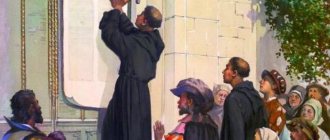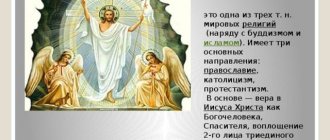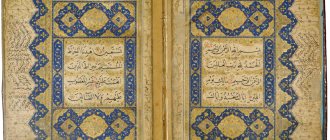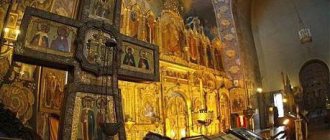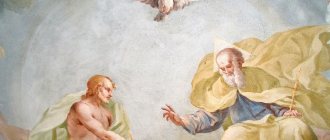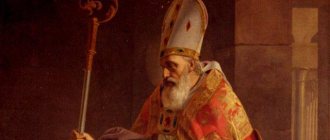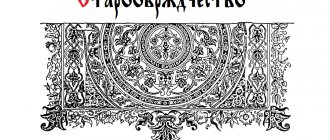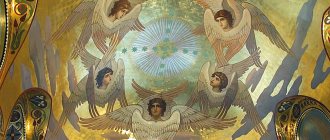author Ivanenko Sergey Igorevich
Pentecostal Christians as one of the main targets of anti-cultists One of the most serious dangers for the Orthodox Church and society, according to anti-cultists, is the so-called “neo-Pentecostalism.” It should be clarified that Christians of the Evangelical Faith
Orthodox Christianity is the leading religion in the post-Soviet countries. In recent decades, various sects and denominations have begun to openly declare themselves. One of these movements is Pentecostals. Who are they and what religion do they preach?
The Pentecostal Church is an evangelical Christian. It is based on the teaching set forth in the book of the Acts of the Apostles. After the resurrection of Jesus Christ, on the fiftieth day, the Holy Spirit descended in the form of tongues of flame, and they were filled with the Holy Spirit, and for the first time began to speak in other tongues, having received the gift of prophecy, they began to preach the Good News to all nations.
Currently, Pentecostal Christians number from 450 to 600 million people. This is the largest Protestant denomination, which ranks second in number among all Christians. There is no single Pentecostal congregation; there are many local churches and associations.
Pentecostals - who are they, and when did this movement begin? In 1901, the Holiness Movement began in the United States. A group of students, studying the reasons for the decline of faith among Protestants, came to the conclusion that this is a consequence of the lack of the gift of “speaking in tongues” among Christians. To receive this gift, they indulged in fervent prayer, which was accompanied by the laying on of hands, after which one of the girls present spoke in an unknown language. The ease of receiving the gift and unusual experiences during speaking in tongues became the reason for the rapid spread and wide popularity of the emerging trend.
This is how Pentecostal Christians appeared. They first found out who they were in Finland, which at that time (in 1907) was part of the Russian Empire. The Pentecostal Church in Russia was first established in 1913 in St. Petersburg, when certain groups of believers began to experience the baptism of the Holy Spirit and received the gift of speaking in tongues. During Stalin's persecution, the Pentecostal movement went underground. But neither the actions of the authorities to destroy Pentecostals, nor attempts to dissolve them in other communities led people to abandon their faith.
Modern Pentecostal Christians - who are they, what are their theological features? They believe that the baptism of the apostles with the Holy Spirit on the fiftieth day after the resurrection of Christ is not only a historical fact, but also a phenomenon that every believer should experience. In our country and in some other countries
Pentecostals call themselves faiths. They believe that the only, most reliable, infallible guide for the life of Christians can only be the Bible, claiming that it is available for reading and study by anyone. Preachers and pastors encourage you to believe, read it, explore it yourself, and build your life according to it. Pentecostals hold prayer meetings, baptisms, and organize charitable and missionary activities.
Pentecostalism is one of the late Protestant movements of Christianity, which arose in the late 19th and early 20th centuries. in USA. Its ideological origins lie in the religious and philosophical movement of revivalism
- “rebirth, awakening”), which arose in the 18th century.
Holiness
Movement that developed within the latter .
Pentecostals attach special importance to the Baptism of the Holy Spirit, understanding it as a special spiritual experience, often accompanied by various emotions, at the moment of which the power of the Holy Spirit descends on the reborn believer. Pentecostals consider this experience identical to that experienced by the apostles on the fiftieth day after the resurrection of Christ. And since this day is called the day of Pentecost, hence the name “Pentecostals”
.
Pentecostals believe that the power a believer receives through the Baptism of the Holy Spirit is manifested outwardly by speaking in “other tongues” (glossolalia). A specific understanding of the phenomenon of “speaking in other tongues” is a distinctive feature of Pentecostals. Pentecostals believe that this is not a conversation in ordinary foreign languages, but a special speech, usually incomprehensible to both the speaker and the listener - however, real-life languages that are unknown to the speaker are also considered a manifestation of this gift. This is a gift given by God for a person’s communication with the Holy Spirit, as 1 Corinthians chapters 12-14 and other places in the Bible speak about it.
Subsequently, the Holy Spirit endows the believer with other gifts, of which Pentecostals especially highlight the gifts of the word of wisdom, the word of knowledge, faith, healing, miracles, prophecy, discerning of spirits, interpretation of tongues. See 1 Corinthians 12:8-10.
Pentecostals recognize two sacraments: water baptism and the Lord's Supper (communion). Some of them understand the sacraments symbolically rather than sacramentally. The following rites are also recognized: marriage, blessing of children, prayer for the sick, ordination, and sometimes washing of feet (during communion).
Who are Pentecostals?
Christians of the evangelical faith—that’s what Pentecostals were called in Russia. If we give a precise definition, we can say that this is a Christian sect that arose in the USA in the 20th century. In their doctrine, Pentecostals proceed from a myth taken from the Gospel. It talks about “the descent of the spirit from above upon the apostles” 50 days after Easter.
Pentecostals talk about him in their sermons. The faith of people of this religious movement is based on the postulates of man’s sinfulness and his salvation through the descent to earth of the Holy Spirit. What is important for ministry? Personal faith, devotion to teaching and complete renunciation of all earthly goods. Often, at collective prayers organized by adherents of the movement, people bring themselves to ecstasy. They claim that at this moment the holy spirit descends on them, and at the same time they receive the opportunity to “speak in other tongues.” This “unearthly” speech gives them the opportunity to communicate with God.
How did the current appear?
Pentecostalism as such arose in the early 20th century in North America. Its ideological roots lie in the religious and philosophical movement of the 18th century, called revivalism. We have a question: where did such a strange name “Pentecostals” come from? Who are these people who consider themselves a separate branch of Christian teaching? As mentioned above, adherents of this religion attach special importance to the Baptism of the Holy Spirit. During the ritual, believers experience, in their opinion, the same emotions as the apostles did when the Holy Spirit descended on them, which occurred on the 50th day after Easter. In the Gospel this moment is called the day of Pentecost. Hence the name of this movement. From America, Pentecostalism spread widely to Europe and the Scandinavian countries. In Russia it appeared on the eve of the First World War in 1914. During the NEP years, the current intensified. The following organizations of this kind enjoy the greatest influence: “Assembly of God” and “Union of God’s Assemblies”.
Pentecostals in Russia
As noted above, in our country the movement arose at the beginning of the last century. The first Pentecostal in Russia is considered to be the German Wilhelm Ebel. During his visit to Asia in 1902, he stopped along the way in Riga, where he founded his representative office of the missionary society. The first Pentecostal organizations in Russia arose in 1907. The preacher of the new teaching was the Norwegian pastor T. Barat. The new religious movement quickly found new adherents. It included Baptists, Adventists, and Christians... Pentecostals assured their new members that they had received the grace of the Holy Spirit, who came to earth in the name of saving people from sins. The first Russian followers of the community were N.P. Smorodin and A.I. Ivanov. It is worth noting that in Russia, as in other countries where Pentecostalism is widespread, adherents of the new religion are not distinguished by the unity of the basic tenets of the teaching. So, for example, Adventists talk about Holy Saturday, Molokans see the meaning of life in moving to Mount Zion - and so on. There is a conditional division into separate groups of Pentecostals: Smorodinites, Leontyevites, Schmidtovites, Voronaevites and others.
Pentecostalism Abroad
In the USA, Pentecostalism is associated with the name of Charles Finney. He believed in him at the age of 21. Then, for 50 years, he preached the new teaching in the USA, Scotland and England. Finney claimed that the image of Jesus Christ once appeared before him. The Holy Spirit that descended on Charles pierced his entire body and soul. After this, Finney believed and began to preach, telling people about this miracle. In this religious movement, another person played an important role. This is Dwight Moody. He lived and preached in the second half of the 19th century. He carried out his first evangelistic campaign at the age of 38. After this man’s sermons, people formed Pentecostal communities, spoke other “angelic” languages, prophesied, healed the seriously ill and performed other “miracles.” Speaking about the history of this movement, we should also mention Charles Fox Parham. He decided to create a kind of Bible school and send out invitations to everyone. 40 students from Kansas responded to his letter. On January 1, 1901, all the followers and their teacher prayed earnestly to God in their school. Student Angessa Ozman, wanting to receive spiritual power, approached Charles and asked the teacher to lay hands on her. At that moment, according to the preacher, a miracle descended on the girl: she forgot her native English language and began to speak Chinese. Many religious adherents consider January 1, 1901 to be the founding date of their community.
Story
The Pentecostal movement arose at the turn of the 19th and 20th centuries in an atmosphere of searching for an answer to the threat of liberal Christianity. It appeared as a result of the merger of several earlier movements, but quickly acquired quite characteristic and independent features.
John Wesley
The beginning of the process that culminated in the emergence of Pentecostalism should be considered the activity of the outstanding 18th century preacher John Wesley, founder of the Methodist Church. Firstly, it was Methodism that became the theological and social context in which Pentecostalism was born a century and a half later [ source?
] .
Secondly, it was during Wesley's sermons, according to some accounts, that phenomena similar to Pentecostal experiences began to occur (although Wesley himself did not encourage them) [ source?
] :
Charles Finney
The next stage in the prehistory of the Pentecostal movement is associated with the name of the famous 19th century preacher Charles Finney. He believed at the age of 21 and became known as a preacher of repentance and revival. He preached for 50 years in the USA, England and Scotland and converted thousands of souls to Christ. He argued that a person must experience the baptism of the Holy Spirit. He had this experience and for the first time, truly used this term. Here's how he describes it:
“Clearly and distinctly, surrounded by a wonderful radiance, the image of Jesus Christ clearly appeared before my soul, so that I think that we met face to face. He did not say a word, but looked at me with such a look that I fell to the dust before Him, as if broken, I sank to His feet and cried like a child. How long, bowing, I stood in adoration I don’t know, but as soon as I decided to take a chair near the fireplace and sit down, the Spirit of God poured out on me and pierced me all over; filled spirit, soul and body, although I had never heard of D.’s baptism with the Saint, much less expected it, and did not pray for anything like that.”
[
source?
]
And one more quote:
“I received a powerful Baptism of the Holy Spirit without the slightest expectation, without having the slightest thought about it. The Holy Spirit descended on me in such a way that it seemed to permeate my body and spirit, like a stream of flowing love, like the breath of God. No words can describe the love that was poured into my heart. I cried loudly with joy and happiness and was finally forced to express my feelings in a loud cry."
.» [
source?
]
Dwight Moody (Moody)
Another person who played a very important role was Dwight Moody. Lived in the second half of the 19th century. At the age of 38 he began his first evangelistic campaign. In 71, he began to pray to be baptized in the Holy Spirit and a few days later experienced the desired state. “I can only say one thing: God revealed himself to me, and I experienced such great pleasure in His love that I began to beg Him to stay longer in His hand.” He founded the Moody Bible Institute of Chicago and appointed as director of this institute a man named Torrey, who gave great attention to this subject in his sermons and preached constantly on it. After Moody's preaching, communities were created where people prophesied, spoke in other tongues, performed healings and other miracles, although he did not emphasize this.
Holiness Movement and Keswick Movement
The Keswick "Higher Life" movement, which became widespread thanks to several American preachers of the "saints movement" (H. W. Smith and W. E. Boardman). In speaking of the “second blessing,” they shifted the emphasis from Wesley's “purity of heart” to “empowerment for service,” and they also talked a lot about divine healing, which is one of the most necessary gifts of the church.
Healing movement
Charles Fox Parham
The beginning is associated with Charles Parham. He was a priest and, reading Acts, came to the conclusion that Christians had a secret that they had lost. Parham understood perfectly well that one could not find a solution, and it was also not possible for any single person to solve this problem. He decided to organize a Bible school, where he should become the director and its student, so that in such a composition he would seek this good. In Topeka, Kansas, he bought the Stone's Folly house and wrote an invitation; 40 students responded.
In December, Parham had to leave for a conference and gave an assignment to his students. Upon his return, he discovered that the school's students, independently reading the book of Acts, came to the same conclusion: in the 5 cases described in Acts, when they were first baptized, speaking in tongues was recorded.
- 1. On the day of Pentecost
- 2. In Samaria
- 3. In Damascus
- 4. In Caesarea
- 5. In Ephesus
The Miracle of Glossolalia
Parham suggested praying to receive such a baptism from God with the sign of tongues. The next day they prayed all morning in the congregation until noon, and all day there was an atmosphere of anticipation in the mansion. At 7 pm on New Year's Eve 1900, student Agnes Ozman remembered the laying on of hands.
This is one of the dates that Pentecostals view as one of the original dates in the history of their movement. They point to that day as the first, since the days of the early church, when the baptism of the Holy Spirit was demanded, when speaking in tongues was expected as the original evidence of the baptism of the Holy Spirit. Charles Parham was very happy that he would now preach everywhere. But he did not reach the middle of Kansas. He was not accepted anywhere, having met with hostility the very idea of speaking in tongues. In America, unregenerate Christians were so cruel to the holiness movement that they caught people going to meetings and beat them with sticks. Charles Parham was unable to continue working at the school, this Stone mansion was sold and nothing further worked out for him.
Welsh Awakening 1904-1905
The revival in Wales developed according to a rather unusual, uncharacteristic scenario, showing the following situations: the conversion to an active Christian faith of people who had previously been completely uninterested in it [ source?
], the absence of court cases (to the point that the city authorities symbolically presented white gloves to the judges - as a sign of their freedom from direct work), the taverns were empty, no more curse words were heard [
source?
], reading pulp novels sharply declined, football clubs (whose games were accompanied by aggression and fights) were disbanded [
source?
], the city's theatrical society left due to a sharp decline in public interest in the theater [
source?
] .
Until December 1904, there were 70 thousand Christian believers; by May 1905 there were already 85 thousand [ source?
] .
In the middle of the last century, the “Holiness Movement” arose, they affirmed the relationship between the new birth and sanctification. People began to become interested in the power of God to act more powerfully in the church. In many cases, according to believers, the power of the Holy Spirit acted in ways that were later adopted and articulated in the Pentecostal movement.
This is the state of the Church in which the Pentecostal movement emerged.
Waking up on Azusa Street
In 1903, Parham moved to Eldorado Spenes and a turning point occurred in his ministry. According to Pentecostals, when he began to preach and pray for the sick, many of them were actually healed. Word spread about him as a selfless person. For example, at one of the meetings, a woman named Mary Arthur, who had lost her sight as a result of two operations, began to see after Parham’s prayer.
Five years later, in Houston, Kansas, Parham announced the opening of a second school. William Seymour, an ordained black minister, came to this school. At the beginning of 1906, Seymour travels to Los Angeles, where he meets preacher Frank Bartelman, who managed to prepare the ground for the coming revival. On April 9, 1906, during one of Seymour's sermons, God began to baptize those listening with the Holy Spirit. He opens the Apostolic Faith Mission at 312 Azusa Street. This place, for a certain time, became the center of the Pentecostal movement. The Azusa Street Revival lasted 3 years (1000 days).
The Norwegian clergyman of the Episcopal Methodist Church, Thomas Ball Barat, having become acquainted with Pentecostal teaching in the United States, was baptized in the Holy Spirit. He brought the message of Pentecostalism to Europe, Scandinavia and the Baltic states. Pentecostalism received the strongest resistance in Germany. What happened at the meetings of Pentecostal preachers was perceived as the work of Satan, and, as a reaction, members of some evangelical churches signed the “Berlin Declaration” in 1910, which stated that the Pentecostal movement originated not from God, but from the devil. It was equated with occult things. Germany was closed to the Pentecostal movement for a long time.
In the 1930s, a man named David Du Plessis (who was nicknamed "Mr. Pentecost") met with a famous Pentecostal preacher, Smith Wigglesworth, who told him that a powerful revival associated with the outpouring of the Holy Spirit would soon visit the traditional churches, and he will have to participate in it. In 1948, while Du Plessis was preparing for a Pentecostal conference, his car was hit by a train. He ended up in the hospital, where he allegedly heard the voice of God: “The time I spoke about has come. I want you to go to other traditional churches."
This was the first step towards the emergence of the charismatic movement.
Oneness Pentecostals
Among Christians of various directions, there are often followers of the doctrine of the uniqueness of God (In brief: there is only one God the Father, and Jesus was only his incarnation, the Holy Spirit is not a person, but a force). In the history of Pentecostalism in Russia, there are also believers who agree with this teaching, the so-called “Smorodinians” (from the surname of the community leader, Smorodin). Other names: “Evangelical Christians in the spirit of the apostles”, “Oneness”.
Pentecostalism today
In our time, this movement in Russia ranks second among all sectarian associations in terms of the number of believers. We currently have three main similar organizations:
- United Church of Christians of the Evangelical Faith.
- Russian Church of Christians of the Evangelical Faith (Pentecostals).
- Russian United Union of Christians of the Evangelical Faith.
In 1995, a community under the leadership of S. V. Ryakhovsky separated from the United Church of Christians of the Evangelical Faith. This man later created the Russian United Union of Christians of the Evangelical Faith. There are other organizations of this kind. It is worth noting that many Pentecostal communities are very active in the social sphere. Some of them provide assistance to orphanages, promote medical funds, and organize youth camps.
Basic Tenets
What do Pentecostals believe? What are they? A lot of questions arise in connection with this religious movement. Let's try to figure it out. Adherents of the religion believe in the life-giving power of the Baptism of the Holy Spirit, which is externally manifested in a person by the ability to speak other languages. Pentecostals believe that when they achieve a special state of mind during evangelization through prayer, members of the sect discover a special gift of speaking in different languages. In addition, such a person may develop a talent for clairvoyance, wisdom, and miracles. An important aspect of the sect’s theology are the so-called “teachings of piety,” which call on followers to give up anything that could interfere with leading a righteous life: smoking, alcohol, gambling, drugs. Some groups of this movement do not recognize weapons, adhering to the doctrine of “non-resistance to evil.”
Ordinary people about the Pentecostal movement
Recently, this movement has been increasingly criticized. People believe that the Pentecostal church and its doctrines are nothing more than a deception of believers. Many call this formation a sect. Apparently this is true. There are many eyewitnesses to how meetings of members of this movement take place.
People write that from the outside it looks like the rampage of a hypnotized crowd, not noticing anything around them and busy only with fervent prayer. The believers are on their knees and screaming furiously, sweating profusely. Speaking in different languages, or so-called glossalia, achieved through diligent prayer, is nothing more than disordered mumbling. Rituals are often performed at night in crowded and stuffy rooms. It is not surprising that under such conditions, when people are highly nervous, they may experience hallucinations that they mistake for a “revelation of God.” Among the sect members there are many mentally ill people. The main task of the preachers of this religion is to lead each new member of the community to such an unbalanced state when a person will not be able to adequately assess the situation and respond to it.
We have answered the main questions related to the term "Pentecostal". Who they are, what they believe, what rituals they perform - everything was discussed in this article.
Rituals
Despite the closedness and isolation of the community, more and more people in Russia come to the meetings of the sect to listen to Pentecostal sermons. Adherents of religion accept the authority of Holy Scripture. However, they arbitrarily distorted the Great Mysteries of Christianity, turning them into simpler rituals. Some semblance of the ritual of the Communion of God is the ceremony of breaking bread, performed on the first Sunday of every month. Members of the sect are invited to take a piece of bread from the tray and take a sip of wine from the cup. At the end of the prayer, the ritual of washing the feet is performed, which men and women undergo separately in different rooms. Pentecostals also have their own “water baptism.” It is very reminiscent of a Christian ritual. But babies are not baptized, but simply brought to the meeting for blessing. People entering married life must undergo a marriage ceremony in the sect. Moreover, an alliance with an unbeliever is strictly prohibited. For disobedience, a member of the community faces excommunication from the church. The rite of ordination or anointing of the sick is performed by Christians of the evangelical faith. Pentecostals believe that this will help those suffering to quickly restore strength and get rid of “illness.” The day of rest for believers is Sunday (except for those who keep the Sabbath). As a rule, at this time, members of the sect gather for prayer meetings. All church holidays (Candlemas, Christmas, Epiphany, Annunciation, and so on) are celebrated according to the old style. Easter falls on Friday of Holy Week.

